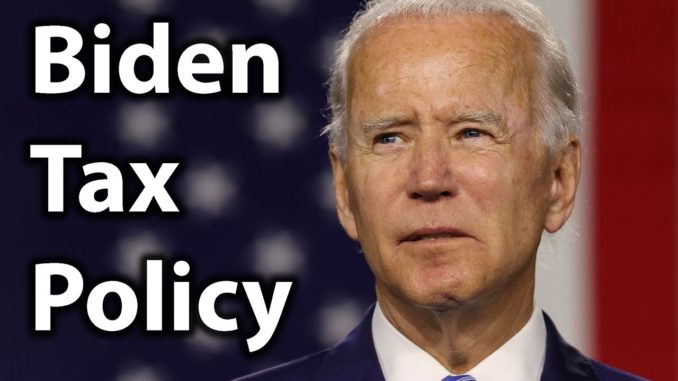
Biden Tax Plan: Who Gets Tax Cuts, Who Gets Tax Hikes By Investors Business Daily
Many voters want to know what the Biden tax plan is.
Would it boost your taxes? Bottom line: Only if you earn more than $400,000 a year — and only if you earn more than $1 million, in some cases. The biggest change, at least for taxpayers who earn less than $400,000? It’s an expanded tax cut, according to one tax expert.
“The expanded child tax credit is the most substantial change for tax payers with incomes below $400,000, both in terms of dollars and number of people affected,” said Gordon Mermin, senior research associate for the Urban Institute.
Assessing the Biden tax plan can be tricky. Foremost, there is no single document called the “Biden tax plan.” It’s more like a jigsaw puzzle. It consists of many pieces. Some of Biden’s proposals are merely campaign talking points — broad ideas lacking details.
Biden Tax Plan: Assembling The Jigsaw Puzzle
To flesh out Biden’s tax plan, the Tax Policy Center (TPC) — which is a nonpartisan joint venture of two prominent think tanks, the Urban Institute and the Brookings Institution — put the jigsaw puzzle together. The TPC analyzed the many separate things Biden and his campaign website have said about how he would change tax rules.
The TPC even asked the campaign to answer questions about Biden’s positions, Mermin says. The overall result is a written analysis of the Biden tax plan by Mermin and five other TPC tax experts.
How Biden’s Plan Impacts Individuals
After crunching numbers, the TPC experts summarize how the Biden tax plan would impact rules for individual taxpayers, not businesses, in 2022 vs. 2020:
- Overall average tax change: Households would overall pay $590 more in taxes. But that’s pulled up by tax hikes on the wealthiest households, Mermin says.
- Impact on the average taxpayer: Tax cut of $1,020. This reflects the average tax change for the middle income quintile (or the middle-income fifth of the population), Mermin says. Each quintile represents one-fifth of the U.S. population. Households in the middle quintile have taxable income of $49,800 to $88,499.
- Impact on the fourth quintile: On average, households in this group, where taxable income would range from $88,500 to $159,799, would get a tax cut of $1,280.
- Impact on the top quintile: Households in the top quintile, where taxable income would be $159,800 or higher, would pay $10,150 more in tax on average. Again, that increase will largely fall on households with the very highest incomes above $400,000.
- Who gets the biggest tax hike: The bulk of that top-quintile tax increase would fall on the very top earners. Only the top 5% of taxpayers would average tax increases, the TPC says. The top 1% of taxpayers would average tax hikes of $221,230.
The TPC numbers are averages. “The average tax increase for the top 5% doesn’t mean everyone in the top 5% pays more,” Mermin said. “And the average tax cuts for the bottom four quintiles don’t mean everyone in the bottom four quintiles pays less.”
How Biden’s Proposals Would Affect You
What do the proposals mean to you? Here are the six proposals in the Biden tax plan with the biggest direct impacts on individuals.
Biden’s Plan For Child Tax Credit
Child tax credit. Currently, the child tax credit offers up to $2,000 for each eligible dependent child who is age 16 or younger. It provides a $500 nonrefundable credit for eligible dependents who are not children. Up to $1,400 of the credit is refundable. It the credit reduces your tax bill to zero, you potentially still get a refund.
- What would change: The credit would expand to $3,000 per child. Eligibility for children would extend to age 17. The new rule would add an extra $600 for each eligible child younger than six. The entire credit would become refundable.
Biden’s Idea For 401(k), IRA Contributions
Tax deductions for 401(k) and IRA contributions. The Biden tax plan would replace the current tax deductions for contributions to traditional 401(k)s and IRAs with a new across-the-board 26% tax credit.
- What would change: If your income is above $400,000 — in the upper part of today’s 35% bracket or anywhere in the 37% — you would be hit with extra tax of up to $206 for every $1,000 you contribute to your 401(k) plan. Taxes would not rise for anyone else, meaning people in the 22%, 24%, 32% and most in the 35% brackets.
Biden Tax Plan: Impact On Social Security Taxes
Social Security payroll taxes. Taxpayers pay the payroll tax on the first $137,700 of their wages. That rises to $142,800 next year.
- What would change: No change on income up to $400,000. Each dollar above that would become subject to the tax. So, someone whose pay is, say, $450,000 would pay 6.2% of their first $142,800 plus 6.2% of $50,000, Mermin says. The same rule would apply to the employer share of payroll tax.
What Happens to Taxes On Capital Gain, Dividends
Tax on capital gains and dividends. For taxpayers whose taxable income exceeds $1 million, cap gains and dividends would be taxed at a new 39.6% rate.
- What would change: Currently the top individual tax rate of 37% applies to people whose income exceeds $518,400 ($622,050 for marrieds filing jointly). The top cap gains rate is 20%. Suppose you have $900,000 in wages plus $200,000 in cap gains next year. Under the Biden tax plan, your wages and the first $100,000 in cap gains would be taxed as they are now (although with new rates and brackets, if applicable). Only the $100,000 of cap gains exceeding the $1 million taxable income threshold would be taxed at the new 39.6% rate.
Tax Proposal’s Impact On Tax Brackets
Tax Cuts and Jobs Act of 2017 (TCJA). Known widely as the Trump tax cuts, the Biden tax plan would repeal the TCJA tax cuts for taxpayers with incomes topping $400,000.
- What would change: For taxpayers earning more than $400,000, the old brackets and rates would return. For example, a single filer got socked with a top rate of 39.6% rate in 2017 if his or her taxable income was more than $418,400. Now, he is not in the new top rate of 37% unless his taxable income is more than $518,400.
- What else would change: The Biden tax plan would cap itemized deductions at 28%, even for taxpayers in higher tax brackets.
Biden Tax Plan Would Change Estate Taxes
Estate tax. The Biden tax plan would restore the estate tax rules of 2009.
- What would change. The current top rate of 40% would be replaced by a top rate of 45%. The exclusion would shrink from today’s TCJA level of $11.58 million for single beneficiaries (double that for married couples) to $3.5 million and $7 million for couples. Exclusions for the generation-skipping transfer tax and gift tax would also be slashed. The exclusion is the amount of an estate (or a gift) that is not subject to those taxes.

